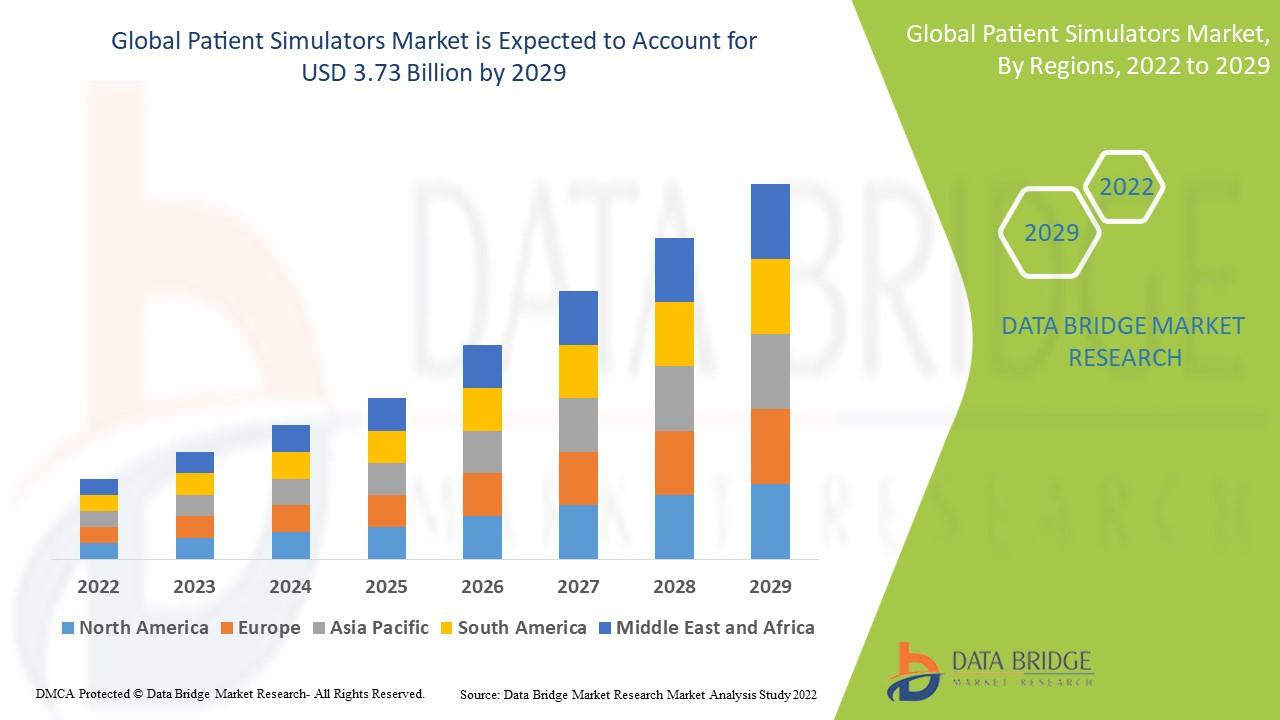Patient Simulators Market: Digital Training Tools in Healthcare Education

"Executive Summary Patient Simulators Market Size and Share: Global Industry Snapshot
CAGR Value
Data Bridge Market Research analyses that the patient simulators market which was USD 1.69 billion in 2021, would rocket up to USD 3.73 billion by 2029, and is expected to undergo a CAGR of 10.40% during the forecast period 2022 to 2029.
Businesses can depend with confidence upon this superior Patient Simulators Market report to bring about an utter success. An expert team involved in creating this report concentrates on understanding client’s businesses and its needs so that the deluxe market research report is delivered to the client. The company profiles of all the dominating market players and brands that are making moves such as product launches, joint ventures, mergers and acquisitions are described in the Patient Simulators Market report. Talented capabilities and brilliant resources in research, data collection, development, consulting, evaluation, compliance and regulatory services work together to formulate this world-class Patient Simulators Market research report.
Patient Simulators Market research report predicts the size of the market with respect to the information on key merchant revenues, development of the industry by upstream and downstream, industry progress, key companies, along with market segments and application. For an actionable market insight and lucrative business strategies, a faultless market research report has to be there. It also becomes easy to analyse the actions of key players and respective effect on the sales, import, export, revenue and CAGR values. This data is useful for businesses in characterizing their individual strategies.
Stay informed with our latest Patient Simulators Market research covering strategies, innovations, and forecasts. Download full report: https://www.databridgemarketresearch.com/reports/global-patient-simulators-market
Patient Simulators Market Trends & Analysis
**Segments**
- **By Product**: High-fidelity Simulators, Medium-fidelity Simulators, Low-fidelity Simulators
- **By End User**: Hospitals, Academic Institutes, Military Organizations, Others
- **By Technique**: Task Trainers, Manikin-based simulators, Virtual Reality simulation
- **By Mode of Operation**: Tethered simulators, Wireless simulators
The global patient simulators market is segmented on the basis of product type, end user, technique, and mode of operation. High-fidelity simulators are expected to witness significant growth due to their ability to closely mimic real-life scenarios and provide a hands-on learning experience. Hospitals are the primary end users of patient simulators, followed by academic institutes and military organizations. Task trainers, manikin-based simulators, and virtual reality simulations are the main techniques used in patient simulators. The market offers both tethered and wireless simulators to cater to the diverse needs of healthcare professionals and students.
**Market Players**
- Laerdal Medical
- CAE Healthcare
- 3D Systems, Inc.
- Gaumard Scientific
- Limbs & Things
- Simulab Corporation
- Simulaids
- Kyoto Kagaku Co., Ltd.
- Mentice AB
- Surgical Science Sweden AB
The global patient simulators market is highly competitive with the presence of several key players. Laerdal Medical, CAE Healthcare, and 3D Systems, Inc. are some of the leading companies in the market, offering a wide range of patient simulators to healthcare institutions worldwide. Gaumard Scientific, Limbs & Things, and Simulab Corporation are also prominent players in the market, known for their innovative and advanced simulators. Other key players in the market include Simulaids, Kyoto Kagaku Co., Ltd., Mentice AB, and Surgical Science Sweden AB, contributing to the growth and development of patient simulation technology.
The global patient simulators market is witnessing a paradigm shift towards more advanced and realistic simulation technologies that are revolutionizing healthcare training and education. One emerging trend in the market is the integration of artificial intelligence (AI) and machine learning (ML) capabilities into patient simulators, enabling enhanced interactivity, adaptive learning scenarios, and real-time performance feedback for learners. This trend is expected to drive the demand for high-fidelity simulators that can accurately replicate complex medical procedures and patient responses.
Another key trend shaping the patient simulators market is the growing adoption of virtual reality (VR) simulation techniques, providing immersive training experiences for healthcare professionals in a safe and controlled environment. VR simulators offer realistic scenarios, interactive learning modules, and the opportunity to practice complex procedures without the need for physical patient involvement. As the technology continues to evolve, VR simulators are expected to become more affordable and accessible, leading to increased adoption across hospitals, academic institutes, and military organizations.
Moreover, the market is witnessing a surge in demand for wireless patient simulators that offer greater mobility, flexibility, and ease of use compared to traditional tethered simulators. Wireless simulators allow learners to move freely during training sessions, simulate real-world scenarios in diverse settings, and collaborate with peers remotely. This trend is driving innovation among market players to develop advanced wireless solutions that meet the evolving needs of healthcare training programs and enhance the overall learning experience for users.
Furthermore, an increasing focus on personalized and competency-based training programs is influencing the design and development of patient simulators with customizable features and adaptive learning algorithms. Market players are leveraging data analytics and simulation modeling to create personalized training modules tailored to the individual skills and learning objectives of healthcare learners. This trend is expected to drive the adoption of patient simulators across a wide range of medical specialties, from emergency medicine and surgery to critical care and obstetrics, catering to the diverse needs of healthcare professionals worldwide.
In conclusion, the global patient simulators market is experiencing rapid innovation and technological advancements that are transforming healthcare education and training practices. With key players continuously investing in research and development to introduce cutting-edge simulation solutions, the market is poised for sustained growth and evolution in the coming years. As the demand for realistic, interactive, and immersive training experiences continues to rise, patient simulators are expected to play a critical role in shaping the future of medical education and improving patient outcomes.The global patient simulators market is undergoing significant transformations driven by advancements in technology and shifting trends in healthcare education. One notable trend is the increasing integration of artificial intelligence (AI) and machine learning (ML) into patient simulators, enhancing realism and interactivity in training scenarios. AI and ML capabilities enable simulators to adapt to learners' performance, provide real-time feedback, and offer personalized learning experiences. This trend is reshaping the landscape of healthcare training by improving the quality and effectiveness of simulation-based education.
Virtual reality (VR) simulation techniques are also shaping the patient simulators market by offering immersive and interactive learning experiences to healthcare professionals. VR simulators enable learners to practice complex procedures in a realistic yet controlled environment, without putting real patients at risk. The growing adoption of VR technology in healthcare training is revolutionizing the way medical professionals acquire and hone their skills, leading to more confident and competent healthcare providers in various specialties.
Another key trend influencing the patient simulators market is the shift towards wireless simulators that provide greater flexibility and mobility during training sessions. Wireless simulators allow learners to move freely, simulate diverse scenarios in different settings, and even collaborate with peers remotely. The convenience and versatility offered by wireless solutions are driving their adoption among healthcare institutions seeking to enhance the practicality and effectiveness of simulation-based training programs.
Furthermore, the focus on personalized and competency-based training programs is driving the development of patient simulators with customizable features and adaptive learning algorithms. Market players are leveraging data analytics and simulation modeling to tailor training modules to individual learners' needs and skill levels. This trend is empowering healthcare professionals to enhance their clinical skills and knowledge in specialized areas, contributing to improved patient care outcomes and medical practice standards.
In conclusion, the global patient simulators market is evolving rapidly to meet the changing demands of healthcare education and training. The integration of advanced technologies like AI, ML, VR, and wireless capabilities is reshaping the way healthcare professionals learn and practice essential clinical skills. As market players continue to innovate and develop cutting-edge simulation solutions, the future of medical education looks promising, with patient simulators playing a crucial role in driving competency, confidence, and excellence in healthcare delivery.
Learn about the company’s position within the industry
https://www.databridgemarketresearch.com/reports/global-patient-simulators-market/companies
Patient Simulators Market Overview: Strategic Questions for Analysis
- How large is the Patient Simulators Market in terms of market cap?
- How rapidly is the Patient Simulators Market expanding globally?
- What are the major verticals identified in the segmentation analysis for Patient Simulators Market?
- Who are the industry leaders mentioned in the Patient Simulators Market report?
- Which countries show strong Patient Simulators Market activity?
- What corporations have major influence on Patient Simulators Market trends?
Browse More Reports:
North America Unmanned Surface Vehicle (USV) Market
Asia-Pacific Meat, Poultry and Seafood Processing Equipment Market
Europe Meat, Poultry and Seafood Processing Equipment Market
Middle East and Africa Meat, Poultry and Seafood Processing Equipment Market
North America Meat, Poultry and Seafood Processing Equipment Market
Europe Neonatal Jaundice Management Market
Asia-Pacific Neonatal Jaundice Management Market
Middle East and Africa Neonatal Jaundice Management Market
North America Neonatal Jaundice Management Market
Asia-Pacific Omega-3 for Food Application Market
Europe Omega-3 for Food Application Market
Middle East and Africa Omega-3 for Food Application Market
North America Omega-3 for Food Application Market
Europe Primary Angle-Closure Glaucoma Market
Asia-Pacific Primary Angle-Closure Glaucoma Market
Global FIDO Authentication Market
About Data Bridge Market Research:
An absolute way to forecast what the future holds is to comprehend the trend today!
Data Bridge Market Research set forth itself as an unconventional and neoteric market research and consulting firm with an unparalleled level of resilience and integrated approaches. We are determined to unearth the best market opportunities and foster efficient information for your business to thrive in the market. Data Bridge endeavors to provide appropriate solutions to the complex business challenges and initiates an effortless decision-making process. Data Bridge is an aftermath of sheer wisdom and experience which was formulated and framed in the year 2015 in Pune.
Contact Us:
Data Bridge Market Research
US: +1 614 591 3140
UK: +44 845 154 9652
APAC : +653 1251 975
Email:- corporatesales@databridgemarketresearch.com
"



